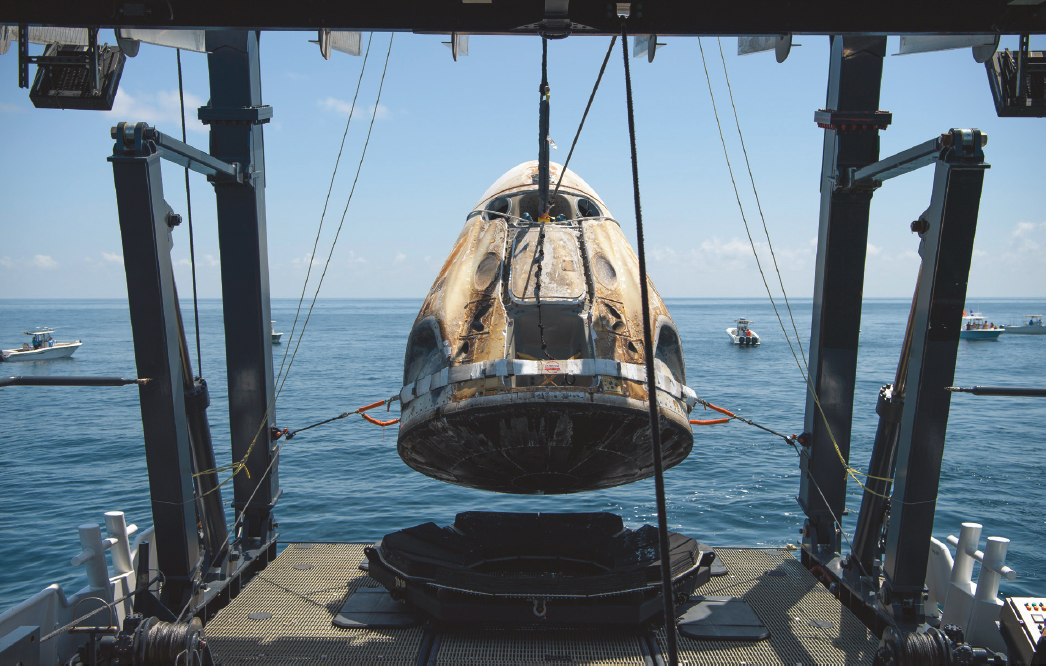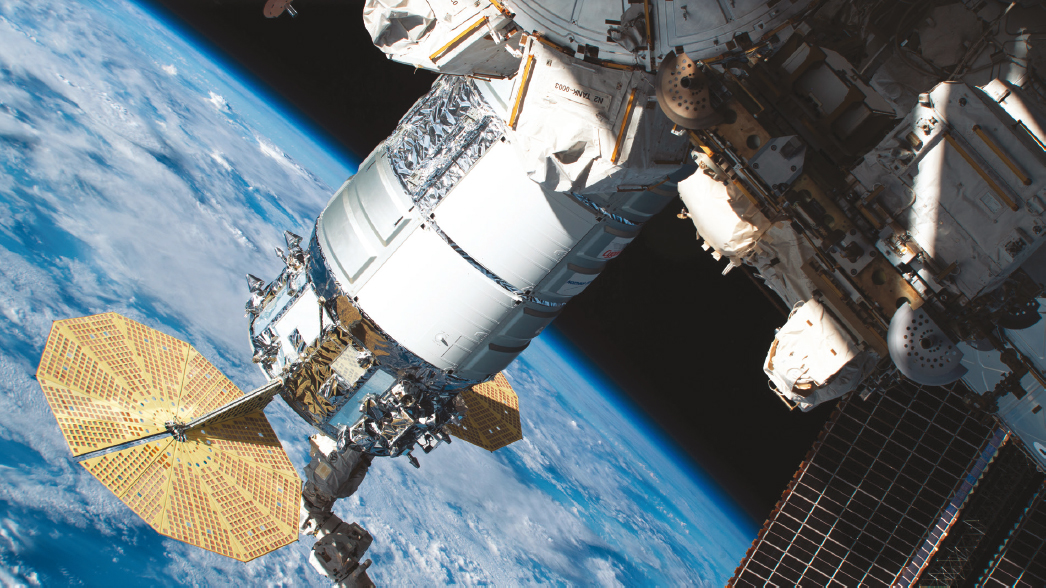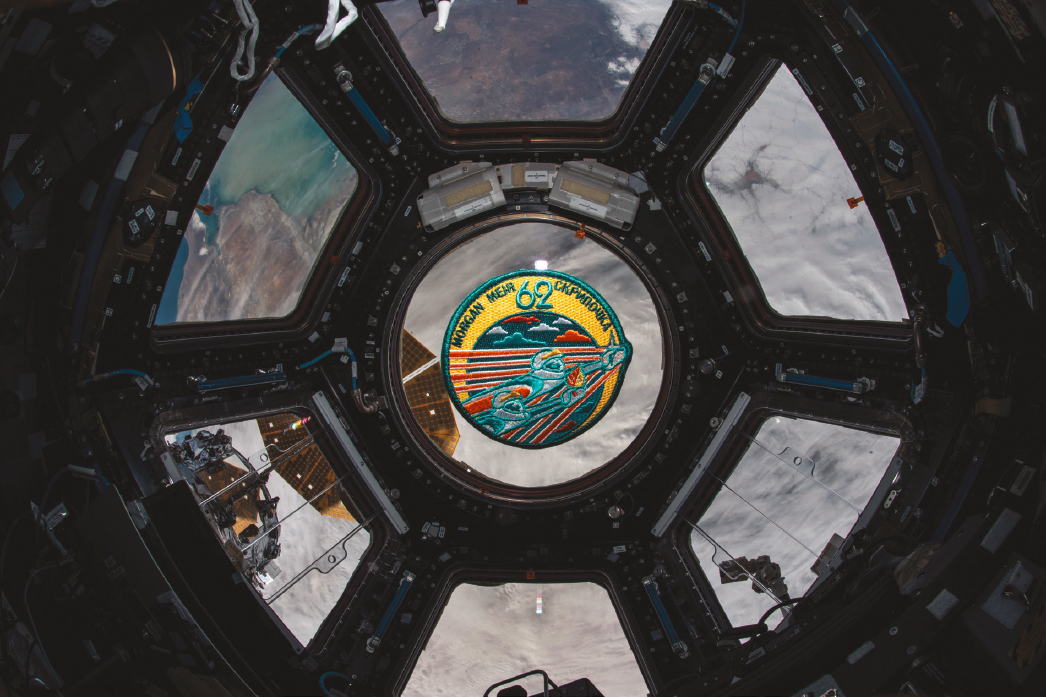3
Framework for Thriving in Space by Prioritizing Themes and Scientific Questions
Reflecting on the impressively broad scope of biological and physical sciences relevant to space (Chapter 1) and the impressively deep insights for science and society over the prior decade (Chapter 2) motivates a major decision point for the coming decade. That decision pivots on how the United States frames the opportunity to focus finite resources of scientific discovery to make the most impactful advances of knowledge in the most complex laboratory known on Earth: the space between our planet, the Moon, and Mars. In the 2011 decadal survey, Recapturing a Future for Space Exploration, during a markedly different point for the U.S. biological and physical sciences (BPS) research community and for NASA, this framework could be described retrospectively as topical in that prioritized research topics were described within many disciplines from plant biology to condensed matter physics, each with the potential to make important advances within that discipline. This was an understandable approach that bridged survival of research disciplines with sufficient expertise, interest in, and access to the space environment by the U.S. research community and facilitated even the possibility of international collaborations by U.S.-based researchers. In the present decadal survey, the framework is thematic and integrative. This is an approach that builds on the BPS research gained over the prior decade, so that both the BPS research community expertise and wider society can thrive in the years of scientific cooperation and competition to come. The framework described below establishes the themes of recommendations to follow in this chapter and in Chapters 4–7. This approach, organized around three inspiring themes, focuses collective attention on the key scientific questions (KSQs) for which answers are required to both explore and benefit fully from global access to the space environment that extends from the surface of Earth to the surface of Mars.
KEY SCIENTIFIC QUESTIONS AS PRIORITIES FOR BIOLOGICAL AND PHYSICAL SCIENCE RESEARCH
Themes
Three themes bind together the scientific priorities of BPS in space environments for the coming decade. These three themes are not unique to this decade, yet the progress in human exploration of space, the scientific achievements and insights of the previous decade, and the rise of commercial development in space exploration and research all bring these themes into sharp clarity as descriptors of scientific importance.
Answering the most fundamental questions about how living organisms function and the universe itself works will continue to require access to the unique features of space. At the same time, the past decade has realized blurring of the boundaries between BPS research to great advantage. For example, answering key questions about vascularized plants or humans in space environments requires awareness of and even automation of the physical principles governing complex fluid flow in microgravity, and answering questions about new materials used to propel or protect humans on the Earth’s Moon or on the way to Mars need to consider the impact of any waste solvents or particulates on future generations of life.
Focusing on the scientific priorities in the following three themes positions the United States to not only travel to but also to thrive in the space environment sustainably, all the while returning benefits to societies on Earth:
- Adapting to Space—Understanding what happens to a terrestrial organism as it leaves Earth. This theme examines the nature of the processes involved in physiological adaptation to space, especially the limitations of that acclimation process, limitations that might affect survival or offer opportunities for decreasing the risk of being in space.
- Living and Traveling in Space—Searching for those principles that guide long-term and safe habitation of space. This theme probes the interactions among life, living systems, and physical structures that are designed for life and life support in space habitation and travel. Included in this theme are the physical phenomena whose understanding is required to safely transit among destinations in space.
- Probing Phenomena Hidden by Gravity or Terrestrial Limitations—Quantifying underlying, fundamental physical and biological processes that are revealed when the experiment is freed from the limitations imposed by Earth. This theme seeks to learn in space what cannot be learned on Earth.
These themes are not exclusionary, as there are phenomena and principles that connect them—principles that ripple through the fundamental fabric of biological and physical structures and functions. These themes do, however, coalesce and categorize specific sets of KSQs—questions that could enable further space exploration and be uniquely enabled by being in space. (See Figure 3-1.)
Criteria Guiding the Selection of Key Scientific Questions
The following criteria served as decisional guidance in the development of the themes and KSQs—perspectives that arose from the 2011 decadal survey and were updated to reflect the current state of BPS science in 2022. These criteria were informed by expert presentations and community input to the steering committee and the panels. These criteria were therefore critical in the development and selection of the KSQs that underpin this report (Chapters 3–5) and the research campaigns that were chosen in part to support rigorous answers to those KSQs (Chapter 6). Such criteria also encouraged clearer articulation of the “so what?” or shared understanding of the importance and implications of answering such scientific questions—clearer to other scientists with varied expertise, and also clearer to decision makers and U.S. taxpayers who support this work through both taxes and career choices. These criteria were given no rank order or weight, yet all served as direct prompts for both identifying and then crafting the narratives for the KSQs, by considering the extent to which the described research developments in candidate scientific questions will, within the next decade:
- Answer grand science challenges and usher transformational change.
- Require access to the space environment to achieve pivotal discoveries.
- Reduce uncertainty about both benefits and risks of space exploration.
- Solve terrestrial problems or yield societal benefit.
- Reduce the costs of space exploration.
- Possibly lead to entirely new options for exploration missions, to bring revolutionary change to space exploration.
Note that the BPS research community recognizes high value in addressing questions that recognize biological processes as being driven by the physical world and describable by physical concepts and measurement, and

that the physical sciences can be biology aware for both inspiration and application. Additionally, in the coming decade there will be some KSQs that seem “purely biological science” without need for new physical insights and capabilities, and there will be some that seem “purely physical science” without regard to biological inspiration, analogy, or application. However, there will also surely be some KSQs that by this coming decade seem to naturally draw from both disciplines and research communities, with biological science–motivated studies being much more physical science-aware, with physical science-focused research being much more cognizant of the implications of research outcomes on biological systems, and with biophysics-grounded research framed as more than an academic fringe topic or subset of BPS.
These three themes help to frame the KSQs that BPS research will address in the coming decade—a decade when space science research will contribute to the canon of knowledge that will help society thrive both on Earth and in the increasingly ambitious space exploration frontiers pursued by the United States and other nations.
Theme 1: Adapting to Space
From the earliest days of the programs dedicated to human exploration of space, there have been keen questions about whether terrestrial biology is capable of functioning in space. Many of those questions were directly associated with the impact of spaceflight on human beings. Most of the data collected until the space shuttle era
were therefore medical in nature. However, once the initial survival of astronauts was assured, science began to expand the theme of space adaptation toward more fundamental questions regarding the entire range of biological processes that can be affected by going into space, including the plants and microbes that will be a part of habitation systems. Major science gains through the space shuttle and ISS decades have been strong increases in understanding what happens to organisms that go to space, at the physiological, cellular, and molecular levels. Three KSQs in this theme for the next decade remain or have arisen from those gains:
- How does the space environment influence biological mechanisms required for organisms to survive the transitions to and from space, and thrive while off Earth?
- How do genetic diversity and life history influence physiological adaptation to the space environment?
- How does the space environment alter interactions between organisms?
These questions begin with an organismal focus, working toward an understanding of what happens to an organism as it leaves Earth and enters the spaceflight environment. Life in space operates differently from life on Earth. Each organism goes through a process of physiological adaptation, a process that has been well discovered in the previous decade and begs to be well understood in the coming decade. Data from the space shuttle and ISS eras strongly suggest that genetic differences imply that not every person, every plant, or every microbe will experience the same adaptive process, or even the same ability to thrive in space. Thus, the direct assessment of the role of genotype in the process of an individual’s adaptations to spaceflight becomes a key question. Moreover, data also suggest that being in space alters the epigenetic characteristics of spaceflight organisms—DNA repair—as well as the interactions between organisms. It is these interactions between organisms that govern complex issues, including pathogenicity. This theme concludes with a KSQ that deals with complex biological systems as they interact to adapt to establish a new stable ecosystem in space. (See Figure 3-2.)

Theme 2: Living and Traveling in Space
The advent of the ISS era was a major inflection point in the trajectory of space biological and physical science. It signaled the transition of science from short-term, sortie missions lasting a few days into the science of long durations of being in space. The ISS created the opportunity for science observations lasting weeks, months, and even years. Moreover, the ISS serves as a test-bed for science and technology for long-duration deep-space missions, such as to the Moon and Mars. This transition in science practice, together with the exploration goals that include missions to the lunar surface, creates a realm of science needs that reflect longer-term interactions between biology and hardware systems, as well as the fundamental physical processes needed to sustainably explore new space locations. Answers to four KSQs are needed to meet these requirements:
- What are the important multi-generational effects of the space environment on growth, development, and reproduction?
- What principles guide the integration of biological and abiotic systems to create sustainable and functional extraterrestrial habitats?
- What principles enable identification, extraction, processing, and use of materials found in extraterrestrial environments to enable long-term, sustained human and robotic space exploration?
- What are the relevant chemical and physical properties and phenomena that govern the behavior of fluids in space environments?
These key questions span a range of investigations from biology through physical science, as well as investigations that integrate across disciplines. These questions formally address the topics of biology and biological systems within the environments built for space explorations. They begin by recognizing that establishing long-term habitation in space requires an understanding of multi-generational effects that arise from reproductive cycles taking place in space. They also address the physical sciences that enable the design and engineering of spaceflight systems. It is understood that scientific knowledge gained by answering these questions is framed specifically to enable society to thrive when accessing the space environment to live for extended times or transit from LEO to Mars. It is also historically likely that this knowledge will be applied in potentially unrelated ways to improve daily life on Earth.
Theme 3: Probing Phenomena Hidden by Gravity or Terrestrial Limitations
Science from the space shuttle and ISS eras has demonstrated clearly that fundamental phenomena in physical and biological systems can be uniquely approached when gravity is removed from the equations. Processes and phenomena that are not observable on Earth can be readily seen in spaceflight. Moreover, spaceflight platforms also present approaches to physical measurements that are limited by the physical distances available on the surface of Earth. There is, therefore, recognition that major science gains are available to space-based laboratories, and those gains are prioritized by these KSQs:
- What are the mechanisms by which organisms sense and respond to physical properties of surroundings and to applied mechanical forces, including gravitational force?
- What are the fundamental principles that organize the structure and functionality of materials, including but not limited to soft and active matter?
- What are the fundamental laws that govern the behavior of systems that are far from equilibrium?
- What new physics, including particle physics, general relativity, and quantum mechanics, can be discovered with experiments that can only be carried out in space?
These questions include consideration of both natural and engineered systems, and may apply to both biological and physical phenomena. For example, cells and tissues can deform under the same mathematical descriptions that predict deformation of complex engineered fluids. These questions uniquely require aspects of the space environment to provide thorough and useful answers. For example, plant root responses to blue light are observable only under microgravity conditions, and spaceflight experiments have determined threshold values for gravity responses
in plants only possible with such space environment access; also, useful observation times of complex fluids when far from thermodynamic equilibrium can require low disturbance levels unique to microgravity. These questions expand Earth-based knowledge about how materials form and change when temperature or other physical conditions change suddenly, how fluids flow differently in space conditions whether to sanitize water, conduct experiments in nanoscale channels, or store propellants, and even how to measure time so precisely that communication and locations can be shared with fellow citizens who participate in space exploration in future decades.
Taken together, these 11 KSQs organized across three themes also reflect divided attention to research impact that is (1) enabling of safe and productive exploration and habitation of space from LEO to Mars, and (2) enabled by access to the space environment—often requiring that access owing to inaccessibility of such environmental features on Earth or predictable by simulation. There is distinct yet equal value in pursuing both types of KSQs in the coming decade, rather than focusing attention only on space mission readiness and sustainable habitation, or only on fundamental research inquiries of potential but currently uncertain societal benefit. Implicitly, this approach also develops a diverse BPS research community and connects increasingly with NASA, other international space agencies, and other U.S. government agencies whose research and readiness missions, and industrial research and development efforts, benefit from answers to these questions.
Table 3-1 summarizes the KSQs for the next decade, discussed more fully in Chapter 4, focusing on space science research that enables safe and productive exploration of space from the ground through LEO and on to the Moon and Mars; and in Chapter 5, focusing on space science research that is uniquely enabled by the characteristics of the space environment.
Recommendation 3-1: NASA should direct its research resources toward the key scientific questions identified in this study (Table S-1 and Chapters 4 and 5).
Recommendation 3-2: NASA should work with other U.S. government agencies and other nations’ space agencies to coordinate research resources toward the key scientific questions, as relevant to multiple-agency missions.
TABLE 3-1 Key Scientific Questions in Biological and Physical Sciences Space Research Over the Decade 2023–2032
| Themes | Key Scientific Questions |
|---|---|
| Adapting to Space (Chapter 4) |
|
| Living and Traveling in Space (Chapter 4) |
|
| Probing Phenomena Hidden by Gravity or Terrestrial Limitations (Chapter 4) |
|
This finite and intentionally prioritized list of KSQs leaves many important lines of BPS research inquiry or conceptual demonstrations on the table; some of these lines of research are more naturally treated as components within integrated research campaigns discussed in Chapter 6. Such a limited list of KSQs is not resilient to the many scientific, economic, and geopolitical surprises that the United States is certain to encounter in the coming decade as in past decades; a recommended decision process to augment and reprioritize KSQs is offered in Chapter 7.
Finding 3-1: The need for science data on exploration of space exceeds the pace of current experiments. Moreover, as exploration and occupation of space increases in the next decade, the rate and replication of science experiments could increase to meet that demand.
Recommendation 3-3: As activity in low Earth orbit increases, and lunar and martian missions are increasingly likely, NASA should increase resources dedicated to understanding the answers to these key scientific questions.
These themes reflect a significant recasting of scientific thought for the BPS community, framing the science not as a collection of phenomena needing to be understood, but as codified pursuit of the underlying principles at play in the space environment. The resulting KSQs represent a deep prioritization of the science within each of the themes. Those KSQs are fully elaborated in Chapters 4 and 5, and are supported in part by the campaigns and initiatives presented in Chapter 6. (See Figure 3-3.)








